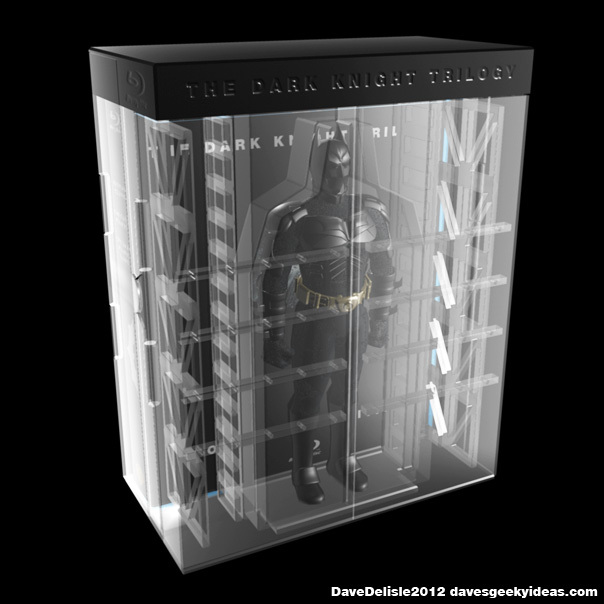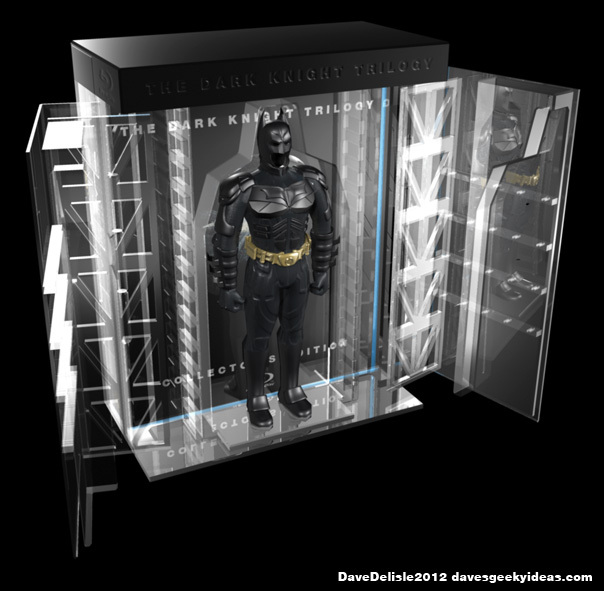Blog Archives
Video Game Power-Up AC Adapter
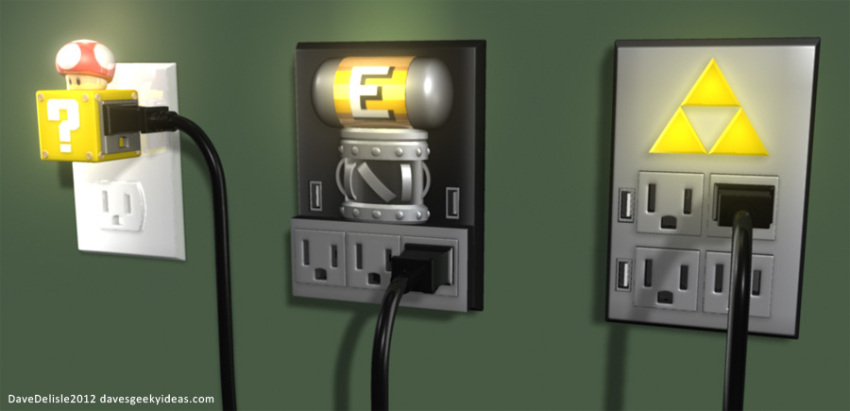
The basic premise here (if it is not already obvious) is a grounded tap adapter which has a video game theme, to give the appearance that you are drawing power from a power-up item. The Triforce of Power, for example, would look like your preferred energy source.
Other bells and whistles include LED night lights (which have light sensors), USB adapters for charging mobile devices, and maybe some sound effects too (when plugging an item in).
I chose to make these tap adapters, because it would be as simple as plugging them in. You could make them specialty outlets too, which you’d have to install in place of a vanilla outlet.
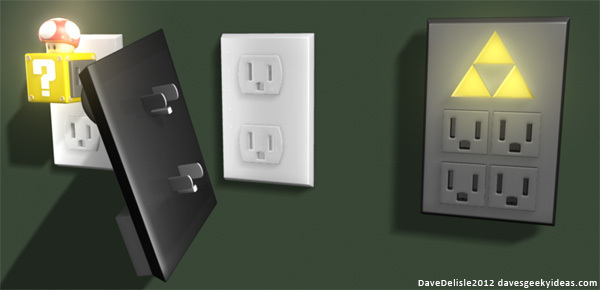
(I added USB ports after I rendered this)
Sorry for just showing Nintendo themed designs! Other outlets can include: the energy tank from Mega Man and the power pellets from Pac-Man to name a few. Another way to go would be outlets that look like game consoles, like a Nintendo 64 or GameCube. This way the sockets could look like controller ports, and the lights would mimic the console’s power indicator.
Personally I’d love to have the Energy Tank from Super Metroid (middle). The ‘E’ would pulse yellow, which would look cool.
Spy Hunter Car Stereo Deck

I thought I’d address the complete lack of geeky car stereo decks with this Spy Hunter design. For the most part it would be your standard stereo, save for a neat cosmetic touch: the back-lit weapons dash that adorned the original arcade cabinet.
These five icons would randomly illuminate (at a slow non-distracting rate) for a bit of a light show. Other touches include 3 buttons found on the steering wheel of the arcade cabinet: the ‘Source’ button disguised as the Weapons Van button, and the play/stop buttons use the same red push-buttons used to fire weapons.
Not only would this deck help recreate the feel of playing the arcade game while behind the wheel of your car, but also grant you delusions of being a badass spy (even if you’re driving a station wagon).
Notes:
You can check out the arcade cabinet in-depth here. This design was based on this Alpine model. The icons would not allow for a CD slot on the face, so if you want CD functionality you would need to pop the face down to load discs. I suppose you could program this sucker to play the Peter Gun Theme upon start-up. Sound effects from the game could be enlisted for button presses.

Thinkgeek IdeaFactory Submission Part 2: Music Visualizer
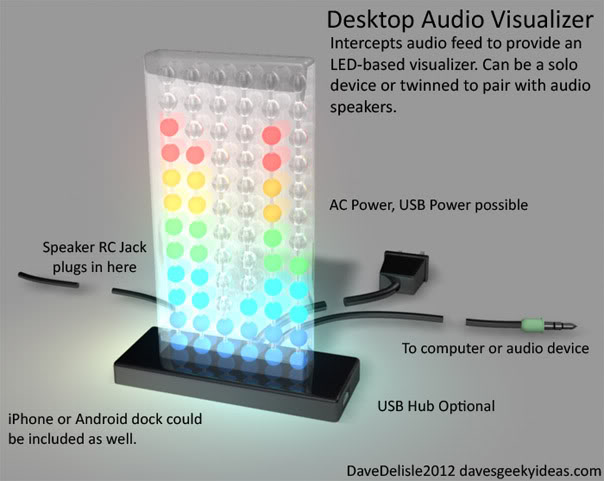
This is a straightforward device: An audio visualizer (represented by a tower of LED lights) that would intercept the audio feed to your speakers from the computer or media player (iPod/iPhone) and display some pretty lights accordingly.
This would operate as visualizer or can become an ambient mood light at the flip of the switch. This can be expanded to be an iOS device dock, and can include a USB Hub to add functionality.
Personally I like idea of a visualizer on my desk for atmosphere, but it is just a cosmetic decoration when all is said and done.
Submission For Thinkgeek’s IdeaFactory Part 1: Desk Dashboard
Thinkgeek has created a portal for people to submit ideas called the Thinkgeek IdeaFactory. Product ideas will be evaluated and should they come to fruition, the submitter can earn some money (payment and royalties) and can re-sell their product if they so choose. They only stipulate that product ideas aren’t based on a licensed property (so no dinnerware based on TRON discs), the products have to stand on their own. I submitted a few designs. Here is the first one:
This is the “Desk Dashboard”. which is like a small clock you keep at your workstation that is plugged into the PC via USB, and is entirely based on the dashboard of an automobile. It emits lights and sounds to notify you of important emails, lunchtime, coffee breaks, and your hourly stand up and stretch health check. Program your routine in the PC and the Desk Dashboard carries it out.
The “Fuel” (Coffee) gauge is a countdown clock to your scheduled coffee breaks. It would not actually be able to detect the coffee level in your cup! Maybe a weight scale peripheral can do that.
The dashboard emits chimes similar to a car, like when the door is ajar and the keys are left in the ignition, or forgetting to put the seat belt on.
It can be expanded to include Facebook and Twitter notifications, an Odometer-style time clock, a hazard light function (red button and yellow blinking lights) to scare co-workers away, and a quitting time alert. Your boss might not be enamored with the last one.
Playstation 2 Vita Pipe Dream
The PS Vita can’t catch a break when it comes to its sales numbers. There are a ton of reasons, and they are the usual suspects: lack of software, too pricey, bad economy, bought a Nintendo 3DS instead, etc. I’d like to offer my own reason, and that is the Playstation brand just isn’t the juggernaut it used to be. When the PSP was released, it rode the coattails of the can’t-lose PS2. A Playstation on-the-go had massive appeal 10 years ago. Now? Not quite as tantalizing a prospect, at least in this blogger’s opinion.
Given the reigns at Sony, my first act to rejuvenate the PS Vita would be to release a peripheral that would allow the transfer of PS1 and PS2 games to the Vita. Backwards compatibility for the masses! Software emulators would be installed on the PS Vita through a firmware update, aided by an external drive device to port over games (as depicted above).
I’m a huge fan of backwards compatibility (well, any added functionality in general). I was quite perplexed when Sony initially offered backwards compatibility for the PS3, only to remove it soon after. Looking back it made a lot of sense for Sony: PS2 was still selling like mad (and those actually made a profit), and the backwards compatibility inflated the PS3′s already-gargantuan cost. So it made sense for the fiscal health of the PS2 and PS3.
If backwards comparability can be removed for the well-being of a console platform, then why can’t it be introduced to help save a platform? Read the rest of this entry
Second Dark Knight Trilogy Blu-Ray Case
This is the second Blu-Ray case design I’ve done for the Dark Knight trilogy, the first one (posted way back in early 2011) was based on the Tumbler. After seeing the costume display case in the Dark Knight Rises, I thought I’d attempt another one.
Oddly enough my first instinct for the original concept was the costume case from The Dark Knight’s Batcave. It was mostly a cage, so it wouldn’t ideally work (media cases need to be somewhat airtight). The fully-enclosed case from Rises works perfectly.
Whenever possible I will try to design standard case design, as most of my designs are too expensive to execute; at least that is the feedback I get from people in the packaged media business. This case is just a plastic box with a few door flaps and an action figure. A more attainable and inexpensive design, than say, that Helicarrier monstrosity.
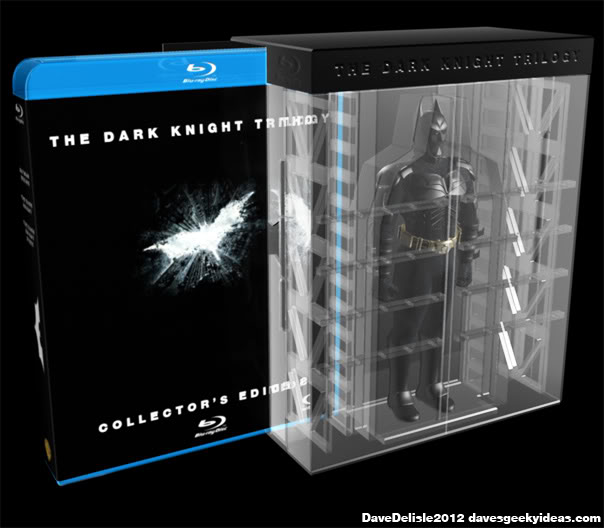
The movies can go into a single thick case, like the recent Jurassic Park Blu-Ray release; or three skinny individual cases, like a TV show box set. The case is stored behind the figure, and is accessible via its own door flap.
The costume depicted is accurate to its portrayal in Rises, which is why there is no cape.
For this release I would include a static figurine (no joints or pose-ability), to keep costs down. A full-fledged figure could be included; ideally with a swappable head so you’d have both Batman and an empty costume. OR you could sell the set with no figure, so fans can add their own 5″ Batman. Then again, there is no such thing as a “frugal” collector’s edition. At least not yet.
These designs have come a long way. Check out this old design I made for Batman The Animated Series (my second Blu-Ray concept). Here is a similar concept for The Incredibles.
Back To The Future iPhone Speaker Dock
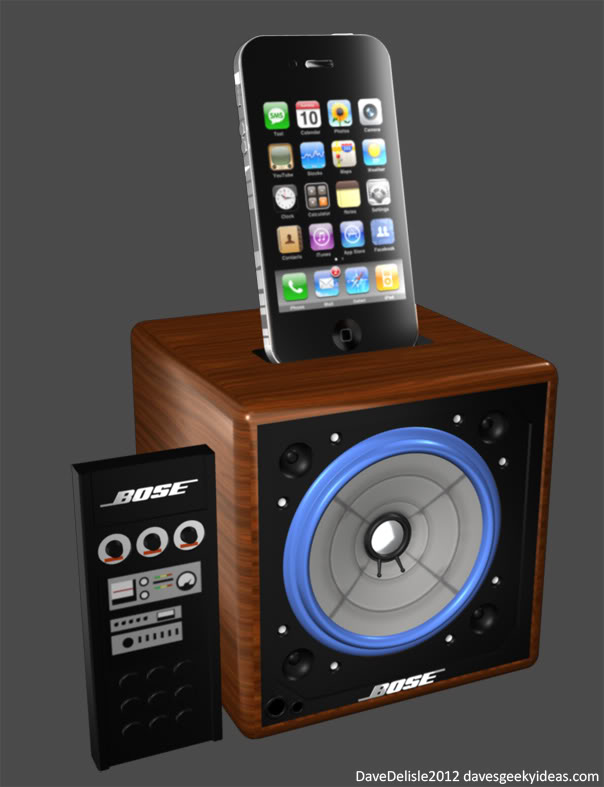
Surprisingly this is the first iPhone dock I have ever designed here (I only designed iPhone chargers previously). Better late than never! And what better than the amplifier that got 20 seconds of screentime in the first Back To The Future film.
Pretty straightforward, an iPhone dock which can also double as an amplifier in a pinch. It comes with a remote which looks like the control console Marty used to adjust the volumes:
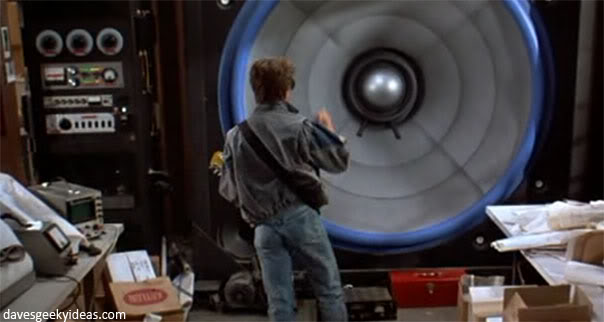
Not only would it look great on the bookshelf or the desk, but it might actually be to scale with a Marty McFly action figure. Did they every make such a thing?
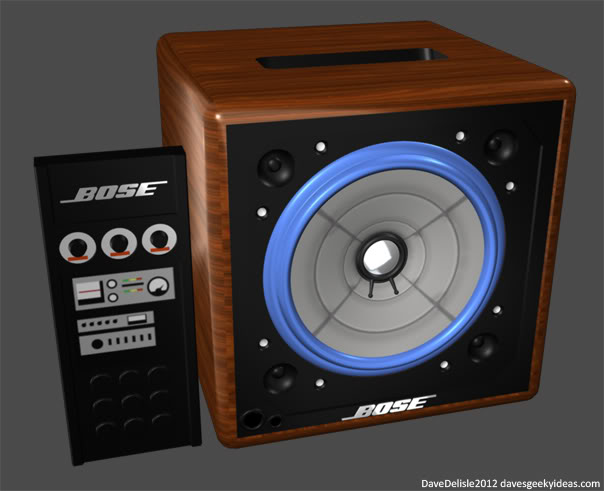
If you liked this BTTF-inspired gadget, check out the rest of them here.
